COLUMN:
Sizing
Up the Competition --
Is
China The Endgame?
by
Dale Allen Pfeiffer, FTW Contributing Editor
for Energy
Sept. 25,
2002, 16:00 PDT (FTW) - In the last 50 years of the United
States' quest for hegemony, it has viewed its chief antagonists
either ideologically (the Soviet Union and Red China),
or economically (Germany and Japan). These antagonists
were either overcome or co-opted. In the last decade of
the 20th century, the U.S. occupied the unparalleled position
of being the world's only superpower. Now, as we enter
the 21st century, this unopposed superpower -- at the
peak of its military supremacy -- may have an Achilles
heel. It is running out of energy and so is the planet
as a whole.
The 20th century
was an era of technological, industrial and economic progress
predicated upon the virtually unrestricted consumption
of resources. But the rampant consumption of the 20 century
cannot last, not on a finite planet where such consumption
is dependent upon nonrenewable resources. The coming century
will be an era of resource depletion, as the greed of
the last century takes its toll upon the planet.
Be this as
it may, the world public does not yet recognize this change.
Consumer demand is ever increasing. In fact, the capitalist
economy is dependent upon ever increasing consumption
-- without it, the economic base will stagnate and collapse.
And while consumer demand for the key item of energy is
expected to increase over the next couple of decades,
energy production has reached a plateau and will begin
an unalterable decline within the next decade. Very soon
there will not be enough.
In the coming
years, continued U.S. hegemony will depend upon maintaining
control and access to the world's dwindling hydrocarbon
reserves, most of which are contained in the Middle East.
In achieving this goal, the U.S. will have to find some
way to deal with those countries which are expected to
take the lead in rising energy demand. Those countries
just happen to be the world's most populous countries,
and all three are Asian. Ranked by population and projected
energy demand, they are China, India and Indonesia.
INDONESIA
With a current
population of 228.4 million, Indonesia has proven oil
reserves of 5 Gb (billion barrels), and in 2001 was producing
oil at a rate of 1.49 million bbl/d (million barrels per
day). Oil consumption for Indonesia currently stands at
1.022 million bbl/d.1
Oil production has actually declined over the past five
years by an average of 2 percent per year. Of an ultimate
30 Gb in oil reserves which this country is expected to
contain, 19.4 Gb have already been produced, leaving an
estimated 10.6 Gb in independently assessed reserves (1.6
Gb of that yet to be found). There is, however, some discrepancy
in the reporting of Indonesian reserves. The Oil &
Gas Journal reports 5 Gb, while World Oil reports 9.67
Gb; independent review of industry assessments by C.J.
Campbell suggests 9 Gb of reserves. Indonesia reached
peak production in 1977 but did not hit the midpoint for
depletion of its oil reserves until 1992. It is currently
depleting its oil reserves at a rate of 4 percent per
year.2 Natural
gas reserves stand at 92.5 Tcf (trillion cubic feet).
Natural gas production is 2.34 Tcf per year, and consumption
is 0.97 Tcf per year. Indonesia currently exports 30 percent
of its oil production and 51 percent of its natural gas
production.3
Indonesia
is a member of the Organization of Petroleum Exporting
Countries, though it may have to withdraw in time as production
declines from its aging oil fields. U.S. oil companies
have been heavily invested in Indonesia's oil resources.
Unocal, Conoco and Exxon-Mobil are involved in new projects
slated to begin production within the next couple of years.
However, even with these major new projects, Indonesia
could become a net importer of oil by the end of the decade.4
On the other
hand, Indonesia is the world's largest exporter of liquefied
natural gas (LNG). Exxon-Mobil, Conoco, BP, Shell and
Italy's Agip are all involved in Indonesian Natural Gas
production. McDermott International has been awarded a
contract for a major gas pipeline to Singapore. Yet despite
its natural gas reserves, Indonesia still relies on oil
for half of its energy needs. It is attempting to shift
to domestic natural gas for power generation, but this
attempt has been thwarted by lack of domestic natural
gas distribution infrastructure.
Indonesia's
energy demands have lessened slightly in response to the
Asian financial crisis of the late-1990s, which severely
impacted the Indonesian economy. The growth rate of the
Indonesian gross domestic product (GDP) in 2001 was 3.1
percent, down more than a third from 4.8 percent in 2000.
The GDP growth rate is expected to be 3.5 percent for
2002. Indonesia's economic collapse in 1998 saw 75 percent
of Indonesian businesses filing for bankruptcy. The country
is now indebted to the International Monetary Fund to
the tune of $43 billion.5
As a result
of the economic collapse, a number of domestic power generation
projects have failed, and several proposed projects were
cancelled. The country is expected to run into a domestic
power supply deficit within a few years, but up to now
foreign investors have shown little interest in new power
generation projects.
INDIA
With a current
population of 1 billion, India is the second most populous
country in the world.6
The population of India is growing much faster than the
population of China, adding 16 million people per year.7 India has proven oil reserves of
4.8 Gb, a production rate of 734,000 bbl/d and a consumption
rate of 1.9 million bbl/d. The difference yields a net
import of 1.1 million bbl/d. India's natural gas resources
are likewise meager, with 22.9 Tcf of proven gas reserves.
Domestic natural gas production is just keeping up with
current natural gas demand, at 752 Bcf.8 However, natural gas demand has risen faster than any other fuel
in recent years, and domestic production cannot keep up
with this growing demand. India is currently the world's
sixth largest energy consumer.9
In total contrast
to its population and the size of its economy, India is
an energy poor country. India's ninth Five-Year Plan stated
that India would run out of oil reserves by 2012. The
plan emphasized the need for new discoveries. However,
there have been no new major finds in recent years. In
the late 1990s, India advertised the sale of 48 oil and
gas blocks, in an effort to boost international investment
in exploration. The initial response was extremely disappointing,
with no bids received from major international oil companies.
The domestic energy picture is further clouded by low
recovery rates, averaging only about 30 percent. This
is far below the world average.10
Natural gas
does not fare much better. The proven gas reserves peaked
a decade ago. Bangladesh is considered the most likely
source for natural gas imports. However, Bangladesh is
very sensitive to the idea of selling off its natural
resources. India is also considering importing gas from
Myanmar.11 Then there is the more costly
idea of importing LNG, most likely from Indonesia and
the Middle East. However, before this would be possible
major investments in LNG infrastructure would be necessary.
Natural gas
and oil pipelines from the Central Asian and Caspian Sea
regions have been proposed, but these are complicated
by the territorial dispute between India and Pakistan.
The Enron-backed Dabhol power plant was to be powered
with natural gas piped from Central Asia. This project,
India's single largest foreign investment project, has
significantly undermined foreign investor confidence in
India. Troubled first by payment and contract disputes
with the power plant's sole customer, the Maharastra State
Energy Board (MSEB), the Dabhol project was also troubled
by a lack of cheap fuel. Enron-backed Dabhol Power Corporation
notified MSEB in April 2001 that it considered MSEB in
breach of contract. Construction activity was suspended
in June 2001. Enron is still seeking a buyer for this
asset, along with three offshore oil and gas fields.12
Even the coal
situation for India is rather bleak. India is the world's
third largest coal producer after China and the U.S. Coal
satisfies more than half of India's energy demands. Power
generation consumes 70 percent of Indian coal, with much
of the remainder consumed by heavy industry. Unfortunately,
India's coal is of a low quality with a high ash content
and a low calorific value. All coking coal must be imported.13
In 1999, India became a net importer of coal.14
While India
is energy poor, its energy demands have grown considerably
and are expected to continue to do so. By 2020 India's
energy demand is expected to increase by more than 2.5
times its present consumption. This will be the result
of population growth, urbanization, higher living standards,
growth of industry, and growth of transportation demands
for both goods and people.15
CHINA
China is the
world's most populous nation, with a current population
of 1.3 billion. The GDP, currently $1.27 trillion, is
growing at 6.7 percent, down from 7.3 percent last year.
Its major trading partners are Japan, the United States,
the European Union, South Korea and Taiwan. China has
maintained a trade surplus for some time, which is responsible
for a significant portion of the bubbling U.S. trade deficit.
While China's trade surplus has been falling in recent
years, this is largely due to imports of capital goods
needed to refurbish outdated industrial facilities.16
This is taken to be an investment which could lead to
a resurge in the trade surplus.
After the
U.S., China is the second largest energy consumer in the
world. The country holds 24 Gb in proven reserves with
potential for significant new discoveries both inland
and offshore. Oil production amounts to 3.3 million bbl/d.
Oil consumption is currently 4.9 million bbl/d and rising.
Net oil imports are currently 1.6 million bbl/d, and also
rising. China holds 48.3 Tcf of proven natural gas reserves,
with production at 0.96 Tcf per year, even with consumption.17
However, natural gas consumption is also expected to rise.
China is 10th on the list of countries ranked by conventional
oil endowment. For the past five years, oil production
has risen by 1 percent per year, which is well below the
rise in demand. To date, China has produced 27 Gb of oil,
out of 52 Gb so far discovered. Another 5.2 Gb are estimated
to still be awaiting discovery, for a total of 57 Gb.
They are expected to reach the midpoint to depletion this
year, with the production peak following next year. The
depletion rate is currently 3.9 percent per year.18
China's primary
energy consumption is now equivalent to a fifth of the
Organization for Economic Cooperation and Development
(OECD) total, and one tenth of the world's total primary
energy consumption. The International Energy Agency (IEA)
expects that China alone will account for 23 percent of
world primary energy demand increase between 1995 and
2020. The OECD will account for another 23 percent, leaving
a little more than half for the rest of the world (which
will include India and Indonesia).19
Currently,
China is the world's third largest oil consumer, behind
the United States and Japan. It is expected to surpass
Japan within the decade and by 2020 reach a consumption
level of 10.5 million bbl/d.20 China only recently became a net importer of oil, as consumption
exceeded production for the first time in 1993. By 2020,
China is expected to import 8 million bbl/d, more than
the projected net imports of Japan, Korea, New Zealand
and Australia combined.21 Oil production in China was virtually
nonexistent 50 years ago. Production rose from 0.5 mb/d
(thousand barrels per day) in 1970 to 3.2 million bbl/d
in 1997. In 1990, China exported five times more crude
oil than it imported, yet by 1997 its imports had grown
to twice the size of its exports.22
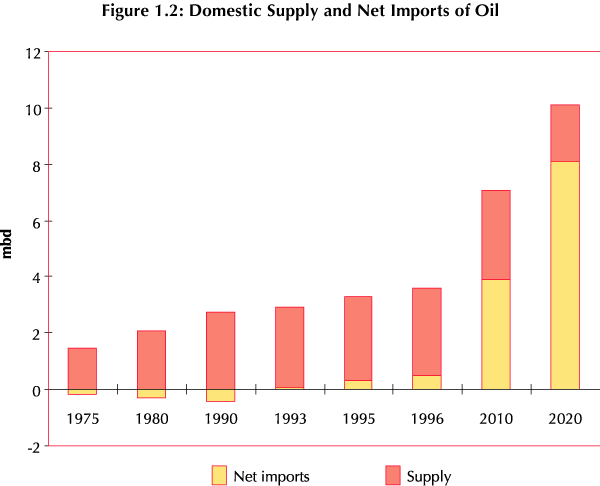
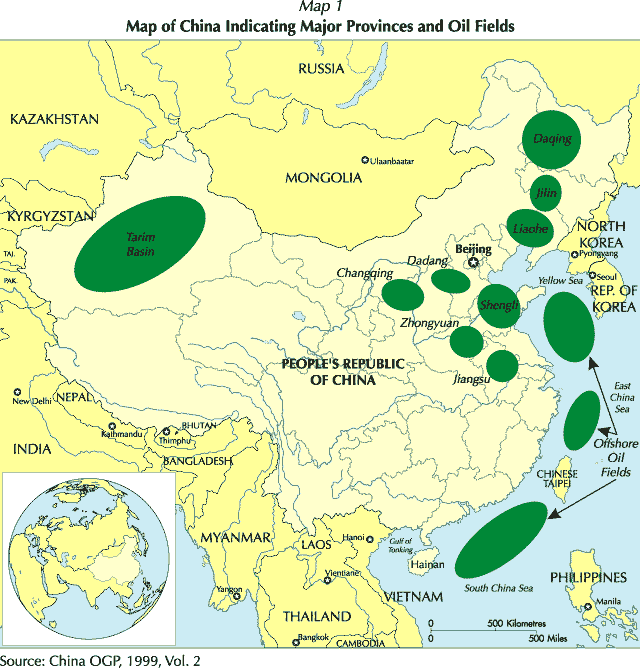
TARIM BASIN
China has
many other unexplored oil prospects, but the country seems
to be pinning its domestic production hopes on the far
western Tarim Basin. This is actually three separate basins
in the Xinjiang Uygur Autonomous Region. This region,
a desert the size of Poland, borders Kazakhstan, Kyrgyzstan
and Tajikistan to the west.23
Estimates of its potential reserves still vary from a
few billion barrels to 80 Gb. Many obstacles impede exploration
and development: deep pay zones, high drilling costs,
complex geology, high subsurface pressures and temperatures,
a harsh climate (temperatures can hit 117 degrees Fahrenheit
in summer and -86 degrees in winter24),
and lack of infrastructure.25 Xinjiang also suffers from antigovernment
violence blamed on its biggest minority group, the Uighurs.26
To get the
oil out of the distant Tarim Basin and bring it to markets
in the east and southwest, China has committed itself
to a 2,604-mile pipeline system. However, with construction
costs estimated at $5.2 billion and Tarim's output growing
more slowly than expected, Chinese officials are struggling
to figure out how to make the pipeline pay for itself.
The Chinese National Petroleum Corporation (CNPC) has
pushed on with smaller investments to build pieces of
the network, hoping that these smaller investments will
render the entire project unstoppable.27
The pipeline is so costly that gas will have to be priced
at 35 percent above what buyers say they are willing to
pay. It is expected that this pipeline will link up with
the even larger "Silk Road" pipeline proposed to bring
oil and natural gas from Kazakhstan.28 To finance the Xinjiang pipeline, China has formed
a partnership with the Royal Dutch/Shell Group, Exxon-Mobil,
and Russia's Gazprom.29
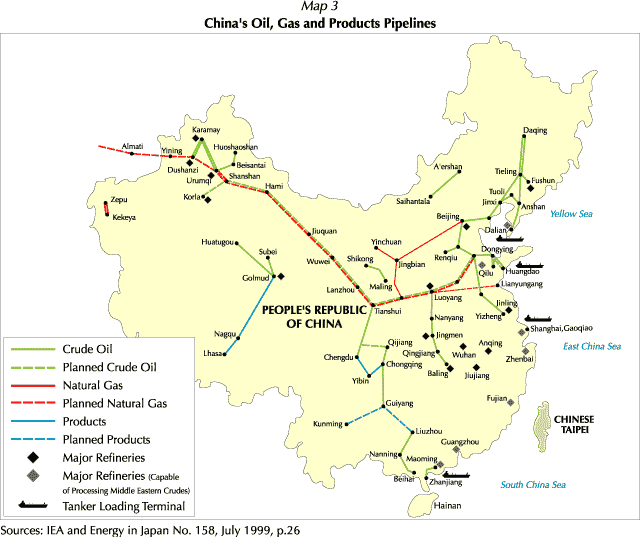
THE ENERGY
SILK ROAD
In partnership
with Exxon and Mitsubishi, CNPC has submitted a preliminary
feasibility study for the world's longest gas pipeline.
Dubbed the Energy Silk Road, this pipeline would start
in Turkmenistan, and stretch across Uzbekistan and Kazakhstan
to Xinjiang's Tarim Basin, a distance of some 4,161 miles.
In Xinjiang, it would link up with the Tarim pipeline
to continue the journey eastward across China. The estimated
cost of $10 billion has stifled investor interest in the
project.30
Similarly, a proposed oil pipeline from Kazakhstan eastward
across China has spurred little investor interest due
to the high price and the difficult terrain which the
pipeline would have to traverse.31
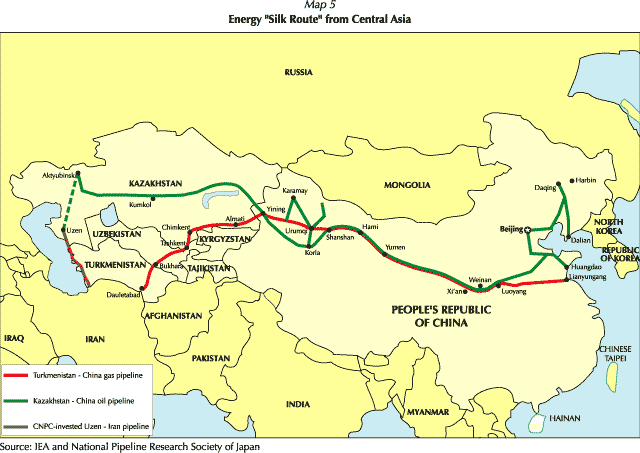
OFFSHORE
OIL
While 90 percent
of Chinese energy production is located inland, it is
beginning to invest more money into offshore production,
with significant prospects to be found in Chinese waters.
The Chinese National Offshore Oil Corporation (CNOOC)
is the company which handles offshore oil production and
exploration. Proven offshore reserves are currently 10.7
Gb in 20 offshore oil and gas fields. Offshore production
quadrupled between 1994 and 1996, and doubled again by
2000. CNOOC has hopes of major increases in production
from fields in the South China Sea. Unconfirmed Chinese
reports place potential South China Sea reserves at 213
Gb. However, in 1994 the United States Geological Survey
estimated resources at 28 Gb.32
Exploratory geologists who have worked in the area or
who have reviewed studies of the area, say that the results
are very disappointing and estimate the South China Sea
area could contain as little as a few billion barrels
in isolated fields.33
Furthermore,
the area is troubled by numerous territorial disputes
involving China, Vietnam, Chinese Taipei, Malaysia, the
Philippines and Indonesia. These disputes have prevented
systematic exploration of the area. There is little indication
that the disputing parties will come to an agreement any
time soon.34 There is some likelihood that increased U.S.
military involvement in the Philippines is at least partially
due to potential or perceived energy resources in the
South China Sea.35
IMPORTS
AND SHIPPING LANES
Far from relying
on inland pipelines for their future natural gas supply,
China is planning on building and updating several LNG
ports so that it might increase its imports of LNG. In
a blow to Indonesia as the top world exporter of LNG,
China has recently awarded a coveted natural gas supply
contract to Australia.36 Part of the reason for favoring
Australia over Indonesia is probably due to the questionable
ability to further crowd traffic in the Strait of Malacca
shipping lane. Currently 1,142 ships per day ply the waters
through this entrance to the South China Sea. Virtually
all Middle Eastern oil shipped to Asian customers must
pass through the Strait of Malacca. A trans-shipment pipeline
across the Malaysian peninsula has been proposed to ease
congestion in the strait.37
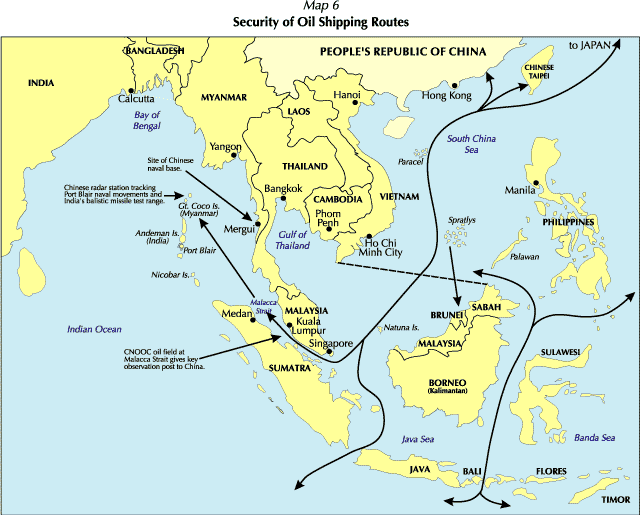
ENERGY
TRADE AND FOREIGN INVESTMENT
China currently
imports oil from many countries throughout the world,
including Iraq, Iran, Saudi Arabia, Sudan, Indonesia,
Angola, Nigeria, Russia, Argentina, Bangladesh, Canada,
Colombia, Ecuador, Mexico, Venezuela and the United States.38 China has attempted to diversify
its energy imports for security reasons. However, like
all other oil importers, it must turn to the Middle East
for the bulk of its needs.
Likewise,
China has had to open itself to foreign investment. This
was one of the conditions for admission to the World Trade
Organization. Among companies investing in China's domestic
energy industry and infrastructure are Saudi Aramco, several
Iranian companies, Enron (until their bankruptcy), Chevron,
Shell, and Exxon-Mobil.39
ENERGY
INFRASTRUCTURE AND GROWING DEMAND
China's energy
problems are exacerbated by inadequate infrastructure.
As mentioned above Chinese production is still growing
at 1 percent, and production is not expected to peak until
next year. However, energy consumption outstripped production
in 1993. Even with all the domestic energy projects on
the board, China's energy demand will still depend upon
imports. Part of the reason for this is that energy reserves
are located some distance from industrial centers and
urban areas, and the infrastructure between energy sources
and centers of demand have not been well developed.
Chinese industrial
energy demand will more than double during the next 20
years. China's electricity demand has doubled within the
last decade and is likely to quadruple by 2020.40
CONCLUSIONS
If energy
demand in China, India and Indonesia is allowed to grow
as much as analysts say it will, then these three countries
may very well crowd the rest of the world out of the energy
market. Furthermore, the studies quoted here do not figure
in oil production peak and beginning production decline
by 2010. These studies are predicated on rising oil production
until at least 2020. Even the Oil and Gas Journal is now
issuing warnings that oil production will not be able
to meet demand by the end of the decade. The IEA forecasts
that world demand for oil will be at 119 mb/d by 2022.
Yet even they offer no word about how this demand will
be met.41
It is plain
that growing energy demands will bring China, India and
Indonesia into conflict with the developed world. The
United States in particular, as the top world consumer
of oil, will likely either have to curb consumption to
make room for other countries or will have to find some
way to curb the demands of the emerging energy consumers.
Moreover, competition for diminishing oil resources could
threaten the U.S. dollar hegemony over world oil transactions.
As competitors
for diminishing oil exports, Indonesia and India might
not present major problems. Being so energy poor, India
may have no choice but to take what they can get. In August
Pakistani President Gen. Pervez Musharaf broke from his
nation's recent political course of exchanging nuclear
threats with neighboring India. Musharaf said he did not
object to India accessing a proposed Central Asian natural
gas pipeline originating in Turkmenistan and running through
Pakistan. If the proposal is materialised, Pakistan could
get [a] $400 to $500 million annual royalty, according
to the Pakistan's DAWN English language newspaper. It
is likely that the U.S. will have no serious problems
in managing India's energy demands.
As for Indonesia,
they are currently in the hands of the IMF and the World
Bank. If these institutions stay true to their usual scam,
Indonesia should soon be completely impoverished. However,
Indonesia does control important shipping routes and valuable
energy reserves. Therefore, it is likely that Indonesia
will see continuing U.S. intervention for the foreseeable
future. U.S. approved political leaders and foreign control
of energy resources will keep Indonesia under control
for at least a little longer.
As a starving
world struggles for the remaining energy scraps, it is
foreseeable that India and Indonesia may be left to starve,
with much of the Third World. Or it is possible that a
nuclear exchange and/or bloody war could be spurred on
between India and Pakistan strictly for the purpose of
population reduction. Such designs are despicable, but
not out of the range of possibility for starving nations.
China, on
the other hand, will be our major competition.
China is unlikely
to become involved in an open war with the U.S. The annual
Chinese military budget was $32 billion in 1997, or roughly
an eighth of the $260 billion U.S. military budget for
the same year.42 The U.S. has military bases throughout Asia,
including the Philippines and Japan, and now in Central
Asia. In the event of a war, the U.S. could easily cut
off Chinese energy imports through the Strait of Malacca
and from Central Asia. A direct war between China and
the U.S. would be a disaster for both countries, and possibly
for the entire world.
Though China
will avoid open warfare with the U.S., they might become
sucked into a war in the Middle East. Should the U.S.
become involved in a protracted war in the Middle East,
it is likely that the opponents would be supplied by China.
In a U.S. military conquest of the Middle East, China
would have to respond by aligning itself with the Muslim
resistance. They would likely do anything short of sending
Chinese troops to the Middle East to fight against the
U.S.
This being
said, China will have to deal with the U.S. empire, and
it will need to force the U.S. into recognizing China
as an equal power. This will most likely be achieved through
economic means, and possibly through a series of minor
wars in third-party countries. Economically, China is
in a very strong position with regard to the U.S. The
Chinese control the U.S. trade deficit, while the U.S.
has very little economic control over China. Should the
Chinese step up the production and export of consumer
goods, the U.S. would have no choice but to swell its
trade deficit even farther. And should China supply more
goods than the U.S. can consume, the economy will suffer.
Likewise, should China move away from the U.S. dollar
as the international currency of trade, the results for
the United States would be disastrous. Ethnic Chinese
control 50 percent of the private capital in the Philippines,
70 percent in Indonesia, 80 percent in Thailand and Malaysia.
The countries of the Pacific produce 60 percent of the
world GDP. In recent sessions of the Asia-Pacific Economic
Cooperation Summit there has been a lot of discussion
about a Pacific alternative to the U.S. dollar. The golden
Yuan has been the leading contender.43
THE FAILURE
OF COMPETITION
In the competition
for declining oil reserves, ultimately everyone will lose.
In the process of struggling for world domination and
energy domination, both militarily and economically, we
will drain the world's remaining energy supplies without
preparing for the coming transition. The net result will
be a tremendous increase in suffering throughout the world,
the further impoverishment of the world's population,
and a semi-secure, semi-comfortable position of limited
power for the elite few who manage to stay on top. Yet
it does not have to be this way.
If the United
States would cut its energy consumption back to sane levels,
there would be enough to build a better world for everyone.
Instead of maximizing profits and trying to corner the
market, we need to undertake a program to restructure
our society. We need to increase energy efficiency and
conservation. We need a massive program to provide more
energy-efficient housing, transportation and industry.
And we need to move from energy-intensive, export-oriented,
and hydrocarbon-based agriculture to more sustainable,
locally oriented, organic agriculture. Along the way,
we can build a more socially responsible, and more democratic
society, where everyone will benefit -- or at least not
as many will perish.
First we have
to deal with our own greed and indifference. And we need
to realize that competition will only result in misery.
To get anywhere, we must act from a foundation of cooperation
and mutual aid. There is very little time left to avoid
a catastrophic future.
Sources: